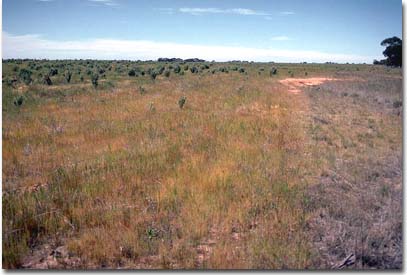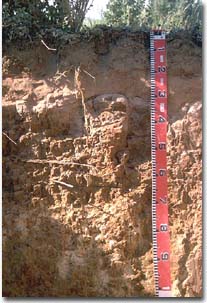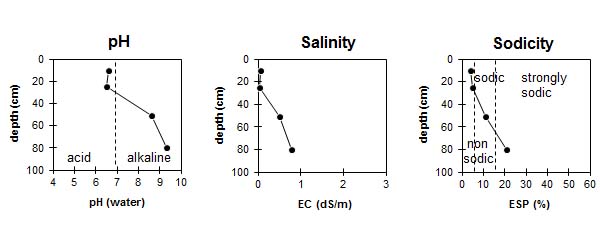LS14a
Location: Propodollah.
Australian Soil Classification: Hypercalcic, Subnatric, Red SODOSOL (sandy)
Northcote Factual Key: Dy 5.43
Great Soil Group: solonetz/solodized solonetz (intermixed)
General Landscape Description: Lower slope of dune on gently undulating sand plain.
 LS14a Landscape |
Soil Profile Morphology:
Surface Soil
| A1 | 0-20 cm | Dark brown (7.5YR3/4); loamy sand; structureless; weak consistence dry; pH 6.6: |  LS14a Profile |
| A2 | 20-30 cm | Yellowish red (5YR4/6); sand; massively structured; firm consistence dry; pH 6.5: | |
| Subsoil | |||
| B21 | 30-35 cm | Yellowish red (5YR5/8); heavy clay; strong coarse columnar (with bleached cemented capping), breaking to strong coarse blocky structure; very strong consistence dry; pH 8.6: | |
| B22 | 35-65 cm | Brown yellow (10YR6/8) with red (2.5YR4/8) mottles; light medium clay; weaker columnar structure; strong consistence dry; contains many (20-50%) soft carbonates; pH 9.3. |
Key Profile Features:
- Distinctive texture contrast between sandy surface (A) horizons and clay (B) subsoil.
Strong coarse columnar structure with bleached capping at top of subsoil.
Soil Profile Characteristics:
| - | pH | Salinity | ||
Surface (A1 horizon) | Slightly Acid | Very Low | Non-Sodic | _ |
Subsoil (B21 horizon) | Strongly Alkaline | Medium | Sodic | Moderate |
Deeper Subsoil (at 0.5 metres) | Extremely Alkaline | Medium-High | Strongly Sodic | _ |

| The surface soil is slightly acid. The subsoil is strongly alkaline becoming extremely alkaline at depth. | The salinity rating is very low in the surface. The subsoil is moderate becoming high with depth. | The surface is non-sodic. The subsoil is sodic becoming strongly sodic with depth. |
Chemical and Physical Analysis:
Horizon | Horizon Depth (cm) | pH (water) | pH (CaCl2) | EC dS/m | Sodium Chloride % | Oxidisable Organic Carbon % | Total Nitrogen % | Exchangeable Cations | |||
Ca | Mg | K | Na | ||||||||
meq/100g | |||||||||||
A11 | 0-20 | 6.6 | 6 | 0.05 | 0.83 | 0.05 | 2.3 | 0.4 | 0.3 | 0.1 | |
A12 | 20-30 | 6.5 | 5.5 | <0.05 | 1.5 | 0.4 | 0.1 | 0.1 | |||
B21 | 30-70 | 8.6 | 7.9 | 0.5 | 0.09 | 8.7 | 12 | 0.9 | 2.5 | ||
B22 | 70+ | 9.3 | 8.5 | 0.78 | 0.12 | 4.5 | 10 | 0.7 | 4 | ||
Horizon | Horizon Depth (cm) | Field Capacity pF2.5 | Wilting Point pF4.2 |
A11 | 0-20 | 5.7 | 2.6 |
A12 | 20-30 | ||
B21 | 30-70 | 32.7 | 21 |
B22 | 70+ |
Management Considerations:
Surface (A) Horizons
- Sandy surface horizons have a very low nutrient status as well as low levels of total nitrogen and organic carbon. Organic matter levels are important for holding nutrients in such light textured soils.
- The available water capacity is very low for the surface horizons due to its sandy texture. However, the low wilting point (15%) means that plants will be able to utilise light rain falling on relatively dry soil.
- Susceptible to wind erosion if surface cover is inadequate. Removal of surface horizons would result in the subsoil being exposed to water erosion forces.
Subsoil (B) Horizons
- The subsoil is sodic and disperses when wet. The top of the subsoil also has a hard cemented capping which is likely to restrict root movement and water movement.
- Soluble salts in the subsoil may restrict growth of salt sensitive plant.
Comments from Landholder:
- Mallee cleared around 1900.
- Salt bush grown for 2 years.
- Superphosphate applied in 1992
- Skeleton weed is a problem.
- Chisel plough used for cultivation.


